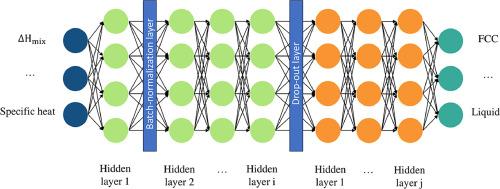当前位置:
X-MOL 学术
›
Acta Mater.
›
论文详情
Our official English website, www.x-mol.net, welcomes your
feedback! (Note: you will need to create a separate account there.)
Deep learning accelerated phase prediction of refractory multi-principal element alloys
Acta Materialia ( IF 8.3 ) Pub Date : 2024-11-12 , DOI: 10.1016/j.actamat.2024.120558 Ali K. Shargh, Christopher D. Stiles, Jaafar A. El-Awady
Acta Materialia ( IF 8.3 ) Pub Date : 2024-11-12 , DOI: 10.1016/j.actamat.2024.120558 Ali K. Shargh, Christopher D. Stiles, Jaafar A. El-Awady

|
The tunability of the mechanical properties of refractory multi-principal-element alloys (RMPEAs) makes them attractive for numerous high-temperature applications. It is well-established that the phase stability of RMPEAs controls their mechanical properties. In this study, we develop a deep learning framework that is trained on a CALPHAD-derived database and is predictive of RMPEA phases with high accuracy up to eight phases within the elemental space of Ti, Fe, Al, V, Ni, Nb, and Zr with an accuracy of approximately 90 %. We further investigate the causes for the low out-of-domain performance of the deep learning models in predicting phases of RMPEAs with new elemental sets and propose a strategy to mitigate this performance shortfall. While our proposed approach shows marginal improvement in accurately predicting the phases of RMPEAs with new elemental sets, we should emphasize that overcoming the out-of-domain problem remains largely challenging, particularly in materials science where there are missing elements or absent material classes in training data hindering predictions, thus slowing the discovery of new potential materials. Predicting phase competition is inherently difficult due to the very small differences in free energies (on the order of meV/atom) that govern competing phases. Current deep learning models, including ours, face significant limitations in capturing these subtle energy differences. Accordingly, more substantial future work is needed to fully address this challenge and achieve robust out-of-domain predictions in complex alloy systems.
中文翻译:

难熔多主元素合金的深度学习加速物相预测
难熔多主元素合金 (RMPEA) 的机械性能可调性使其在众多高温应用中具有吸引力。众所周知,RMPEA 的相稳定性控制着它们的机械性能。在这项研究中,我们开发了一个深度学习框架,该框架在 CALPHAD 衍生的数据库上进行训练,可以高精度地预测 Ti、Fe、Al、V、Ni、Nb 和 Zr 元素空间内多达 8 个相的 RMPEA 相,准确率约为 90%。我们进一步调查了深度学习模型在预测具有新元素集的 RMPEA 阶段时域外性能低的原因,并提出了一种缓解这种性能不足的策略。虽然我们提出的方法在准确预测具有新元素集的 RMPEA 相方面显示出边际改进,但我们应该强调,克服域外问题在很大程度上仍然具有挑战性,尤其是在材料科学中,训练数据中缺失元素或缺失的材料类别阻碍了预测,从而减慢了新潜在材料的发现。预测相竞争本身就很困难,因为支配竞争相的自由能差异非常小(在 meV/原子量级)。当前的深度学习模型,包括我们的深度学习模型,在捕获这些细微的能量差异方面面临着重大限制。因此,未来需要更多实质性的工作来充分应对这一挑战,并在复杂合金系统中实现稳健的域外预测。
更新日期:2024-11-12
中文翻译:

难熔多主元素合金的深度学习加速物相预测
难熔多主元素合金 (RMPEA) 的机械性能可调性使其在众多高温应用中具有吸引力。众所周知,RMPEA 的相稳定性控制着它们的机械性能。在这项研究中,我们开发了一个深度学习框架,该框架在 CALPHAD 衍生的数据库上进行训练,可以高精度地预测 Ti、Fe、Al、V、Ni、Nb 和 Zr 元素空间内多达 8 个相的 RMPEA 相,准确率约为 90%。我们进一步调查了深度学习模型在预测具有新元素集的 RMPEA 阶段时域外性能低的原因,并提出了一种缓解这种性能不足的策略。虽然我们提出的方法在准确预测具有新元素集的 RMPEA 相方面显示出边际改进,但我们应该强调,克服域外问题在很大程度上仍然具有挑战性,尤其是在材料科学中,训练数据中缺失元素或缺失的材料类别阻碍了预测,从而减慢了新潜在材料的发现。预测相竞争本身就很困难,因为支配竞争相的自由能差异非常小(在 meV/原子量级)。当前的深度学习模型,包括我们的深度学习模型,在捕获这些细微的能量差异方面面临着重大限制。因此,未来需要更多实质性的工作来充分应对这一挑战,并在复杂合金系统中实现稳健的域外预测。


















































 京公网安备 11010802027423号
京公网安备 11010802027423号